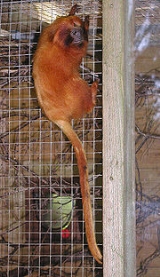
Golden Lion Tamarin
Overview
The golden lion tamarin (Leontopithecus rosalia, Portuguese
: Mico-leão Dourado) also known as the golden marmoset, is a small New World monkey
of the family Callitrichidae. Native to the Atlantic coastal forests of Brazil
, the golden lion tamarin is an endangered species
with an estimated wild population of "more than 1,000 individuals" and a captive population maintained at approximately 490 individuals.
The golden lion tamarin gets its name from its fiery orange or red pelage and the extra long hairs that form along its cheek, throat and ears, giving it a distinctive mane.
Brazilian Portuguese
Brazilian Portuguese is a group of Portuguese dialects written and spoken by most of the 190 million inhabitants of Brazil and by a few million Brazilian emigrants, mainly in the United States, United Kingdom, Portugal, Canada, Japan and Paraguay....
: Mico-leão Dourado) also known as the golden marmoset, is a small New World monkey
New World monkey
New World monkeys are the five families of primates that are found in Central and South America: Callitrichidae, Cebidae, Aotidae, Pitheciidae, and Atelidae. The five families are ranked together as the Platyrrhini parvorder and the Ceboidea superfamily, which are essentially synonymous since...
of the family Callitrichidae. Native to the Atlantic coastal forests of Brazil
Brazil
Brazil , officially the Federative Republic of Brazil , is the largest country in South America. It is the world's fifth largest country, both by geographical area and by population with over 192 million people...
, the golden lion tamarin is an endangered species
Endangered species
An endangered species is a population of organisms which is at risk of becoming extinct because it is either few in numbers, or threatened by changing environmental or predation parameters...
with an estimated wild population of "more than 1,000 individuals" and a captive population maintained at approximately 490 individuals.
The golden lion tamarin gets its name from its fiery orange or red pelage and the extra long hairs that form along its cheek, throat and ears, giving it a distinctive mane.
Unanswered Questions

